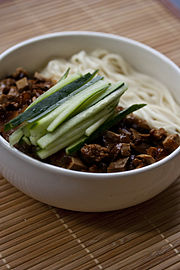This article needs additional citations for verification. (April 2008) |
 A bowl of zhajiangmian garnished with cucumber | |
| Alternative names | Noodles with soybean paste,[1] noodles with fried bean sauce[2] |
|---|---|
| Type | Chinese noodles, Banmian |
| Place of origin | Shandong, China |
| Main ingredients | Cumian, pork, fermented soybean paste |
| Zhajiangmian | |||||||||||||||||||||||
|---|---|---|---|---|---|---|---|---|---|---|---|---|---|---|---|---|---|---|---|---|---|---|---|
| Chinese name | |||||||||||||||||||||||
| Simplified Chinese | 炸酱面 | ||||||||||||||||||||||
| Traditional Chinese | 炸醬麵 | ||||||||||||||||||||||
| Hanyu Pinyin | zhájiàngmiàn | ||||||||||||||||||||||
| Literal meaning | "fried sauce noodles"[3][4] | ||||||||||||||||||||||
| |||||||||||||||||||||||
| Korean name | |||||||||||||||||||||||
| Hangul | 작장면/자장몐 | ||||||||||||||||||||||
| Japanese name | |||||||||||||||||||||||
| Kanji | 炸醤麺 | ||||||||||||||||||||||
| Kana | ジャージャー麺 | ||||||||||||||||||||||
Zhajiangmian (Chinese: 炸醬麵; pinyin: zhájiàngmiàn), commonly translated as "noodles served with fried bean sauce",[2] is a dish of Chinese origin consisting of thick wheat noodles topped with zhajiang, a fermented soybean-based sauce. Variations may include toppings of fresh or pickled vegetables, beans, meat, tofu, or egg. In the Western press, it is occasionally dubbed "Beijing bolognaise" due to its superficial similarity (both dishes involve noodles with minced meat sauce) and ubiquitous nature.[5]
Zhajiangmian originated in Shandong, China and is a popular dish that has evolved into distinct versions across many cuisines both within and beyond China. The most well-known variation is arguably Beijing zhajiangmian (北京炸醬麵),[1][3][6][7] which is recognized as one of the Ten Great Noodles of China (中國十大麵條).[8] Zhajiangmian has also been adapted into the cuisines of South Korea (as jajangmyeon), and Japan (as jajamen).
- ^ a b Sullivan, Lawrence R.; Liu-Sullivan, Nancy (2021). Historical Dictionary of Chinese Culture. Rowman & Littlefield Publishers. p. 51. ISBN 9781538146040.
Other notable dishes and snacks identified with Beijing include the following: dumplings (jiaozi); noodles with soybean paste (zhajiangmian); [...].
- ^ a b Song, Weijie (2018). Mapping Modern Beijing: Space, Emotion, Literary Topography. Oxford University Press. p. 141. ISBN 978-0-19-020067-1. Retrieved 2023-04-06.
[...] Beijing-style buns and noodles, such as steamed buns stuffed with sweetened bean paste (豆包), noodles served with fried bean sauce (炸醬麵), [...].
- ^ a b Dunlop, Fuchsia (2019). Every Grain of Rice: Simple Chinese Home Cooking. Bloomsbury Publishing. p. 141. ISBN 978-1-5266-1784-2.
'Fried sauce noodles', or zha jiang mian, is a Beijing specialty that is now popular all over the country.
- ^ Le, Mike; Le, Stephanie (2022). That Noodle Life: Soulful, Savory, Spicy, Slurpy. Workman Publishing Company. p. 191. ISBN 9781523508556.
Beijing's signature noodle is zha jiang mian, or fried sauce noodles.
- ^ "Beijing-style noodles with minced pork (Aka Chinese bolognese)". 28 May 2021.
- ^ Phillips, Carolyn (2016). All Under Heaven: Recipes from the 35 Cuisines of China [A Cookbook]. Clarkson Potter/Ten Speed. p. 42. ISBN 9781607749820. Retrieved 2023-04-06.
Zhajiangmian means "deep-fried sauce noodles" [...] most folks think of this dish as being from Beijing
- ^ Ku, Josh (2023). Win Son Presents a Taiwanese American Cookbook. ABRAMS. p. 85. ISBN 9781683359906. Retrieved 2023-04-06.
- ^ He, Weijie; Chen, Xin (2013-07-09). "中国"十大面条"公布:云吞面落榜 热干面雄起" [China's 'Ten Great Noodles' Announced: Wonton Noodles misses the cut, Hot Dry Noodles triumphs]. Yangcheng Evening News (羊城晚报) (in Chinese). Retrieved 2023-04-06.